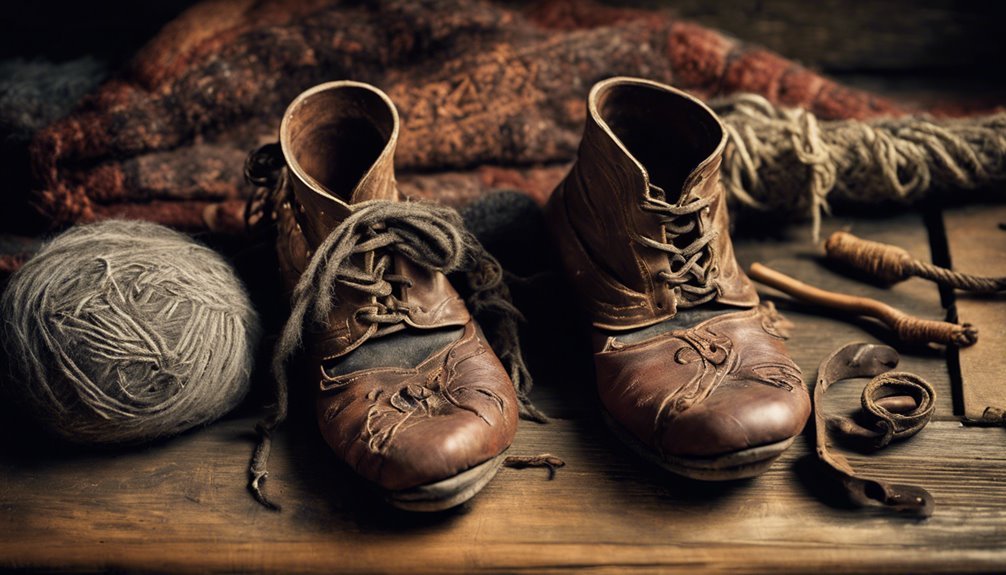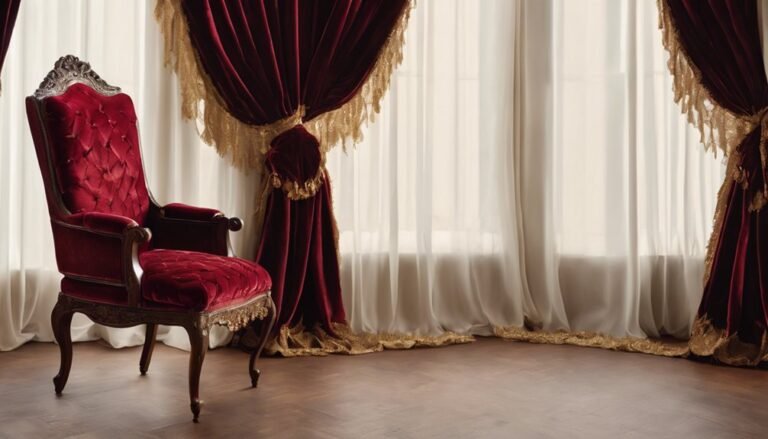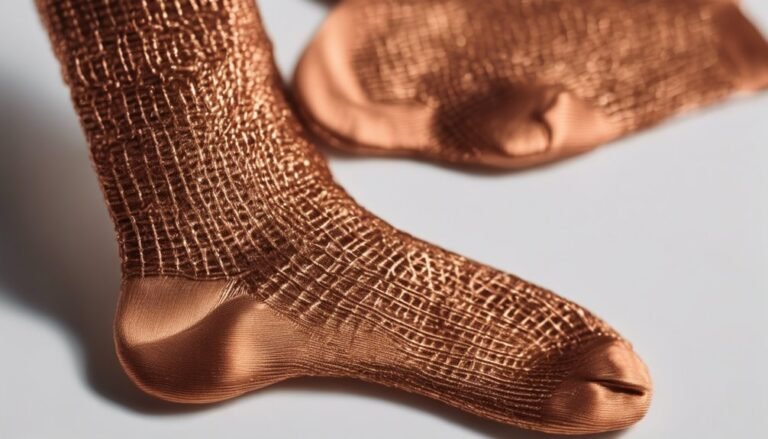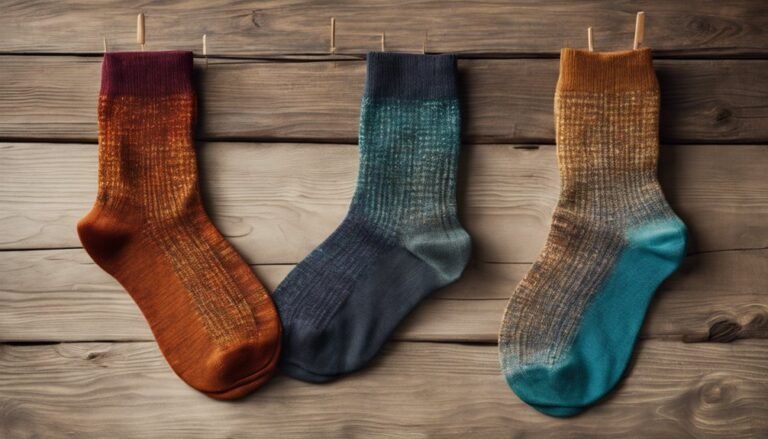Did Vikings Wear Socks? A Look at Ancient Footwear
Have you ever noticed how we often overlook the details of ancient clothing? Imagine stepping into the frigid Nordic landscape, where staying warm is a matter of survival.
In such conditions, one might wonder, did Vikings wear socks? The answer is yes, they did. Vikings crafted socks using durable wool and the naalbinding technique, a precursor to knitting, ensuring warmth and comfort in cold climates.
Their footwear design prioritized functionality, reflecting adaptability to diverse terrains. Archaeological discoveries, like woolen sock fragments, underline their practical approach to surviving harsh conditions.
By understanding the materials and techniques, you uncover the connection between Viking socks and their societal significance, inviting further exploration.
The Origins of Viking Footwear
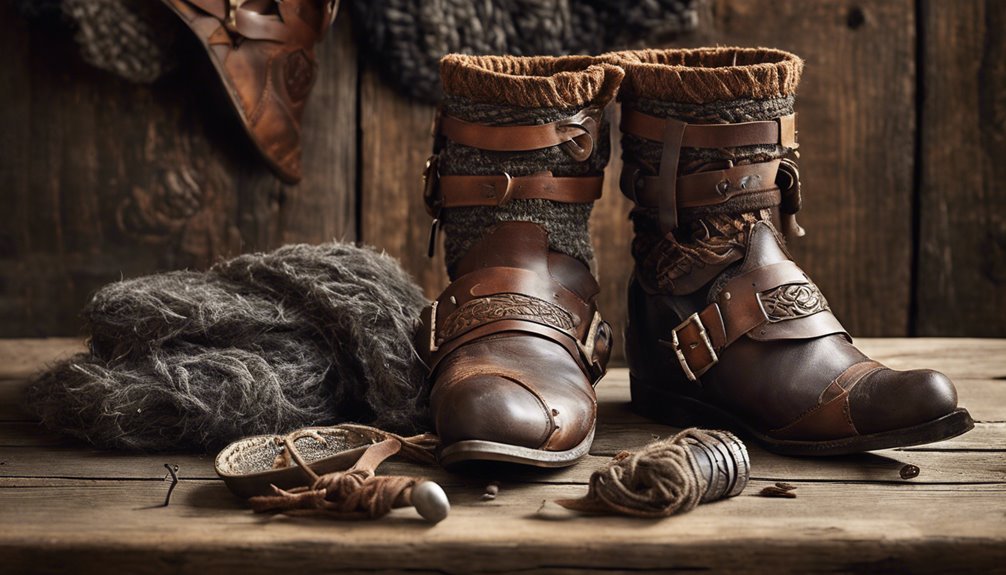
Although often overshadowed by their exploits, the Vikings' footwear played an essential role in their daily lives and expeditions. Viking shoe styles were not just about protection but also about adaptability to diverse terrains. The evolution of their footwear reveals a culture attentive to craftsmanship and practicality. You'd notice that their shoes were typically made with durable leather, ensuring longevity and flexibility. This design allowed Vikings to traverse rugged landscapes with ease, facilitating their renowned seafaring journeys and conquests.
Moreover, these styles varied across regions, reflecting a blend of local influences and technological advancements. By examining archaeological finds, like those unearthed in Scandinavian bogs, you can trace how Viking footwear evolved over centuries, revealing insights into their daily routines and social structures.
Materials Used in Viking Socks
Viking socks, an often overlooked component of their attire, were crafted from various materials that reflected the resourcefulness and ingenuity of this ancient culture. Wool was a primary material, prized for its warmth and durability, essential during harsh Scandinavian winters. The textures of these socks varied, with some offering a coarser weave for strength and others a softer finish for comfort. Beyond practicality, Vikings employed ancient dyes to add color to their footwear, using natural sources like plants and minerals. This not only demonstrated their creativity but also their deep connection to nature. By understanding the materials and methods in Viking sock-making, you can appreciate the freedom and adaptability central to their way of life, where even small details played a significant role.
Archaeological Discoveries of Viking Foot Coverings
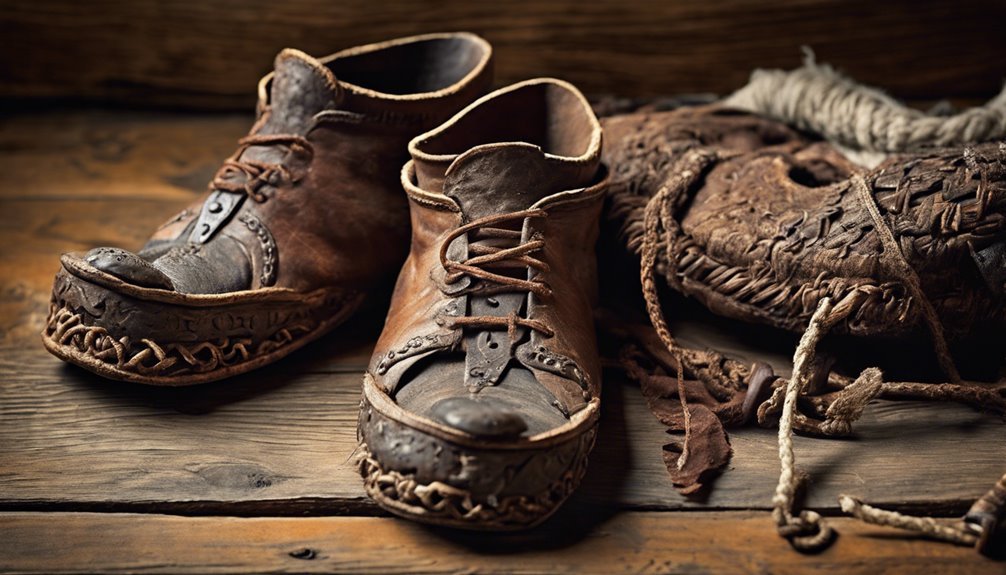
When exploring the archaeological findings of Viking foot coverings, you'll find that woolen sock fragments have been unearthed, indicating their use in cold climates. Evidence suggests that techniques for preserving leather shoes were remarkably advanced, as seen in several well-preserved specimens. These discoveries provide essential insights into the materials and methods employed by the Vikings to protect their feet.
Woolen Sock Fragments Found
Evidence of Viking craftsmanship has taken a fascinating turn with the discovery of woolen sock fragments. These remnants reveal much about the woolen sock benefits and ancient sock uses. You can almost picture the Vikings, their feet shielded from harsh Nordic elements. Here's what's been unearthed:
- Materials: Wool's natural insulation and moisture-wicking properties provided warmth and dryness.
- Weaving Techniques: Intricate patterns suggest skilled craftsmanship, offering comfort and durability.
- Preservation: The condition of these fragments points to careful maintenance, emphasizing their value.
- Daily Life: Socks weren't just practical; they highlighted societal status and personal identity.
Leather Shoe Preservation Techniques
Leather shoes, more than mere foot coverings, offer a window into the Vikings' resourcefulness and adaptability. You'd be surprised by the meticulous leather preservation techniques they employed. Historical techniques reveal their understanding of tanning methods that allowed leather to endure harsh climates. Boggy conditions in archaeological sites have preserved Viking shoes, shedding light on their craftsmanship.
These shoes weren't just utilitarian; they were crafted to last, showing an acute awareness of material properties. Here's a glimpse into what was discovered:
| Feature | Emotional Impact |
|---|---|
| Intricate Stitching | Awe at their skill |
| Durable Soles | Admiration for practicality |
| Preservation in Bogs | Fascination with history |
| Craftsmanship | Inspiration in resourcefulness |
You can almost feel the Vikings' spirit of independence, as they navigated their world with such ingenuity.
Techniques for Making Viking Socks
Crafting Viking socks requires a keen understanding of the ancient naalbinding technique, a predecessor to modern knitting and crochet. This intricate method, rich in historical patterns, involves interlocking loops of yarn, which creates a durable and flexible fabric. To visualize the process:
- Select Wool: Choose high-quality wool, reflecting the Vikings' preference for natural fibers.
- Prepare Needles: Use bone or wood needles, as metal was a rare commodity.
- Sock Weaving: Follow specific regional patterns, each telling a story of its origin.
- Stitch Technique: Employ the Oslo stitch, a fundamental naalbinding stitch, ensuring a snug fit.
Each step is an exercise in precision and creativity, offering you the freedom to explore and recreate an essential part of Viking attire.
The Role of Socks in Viking Society
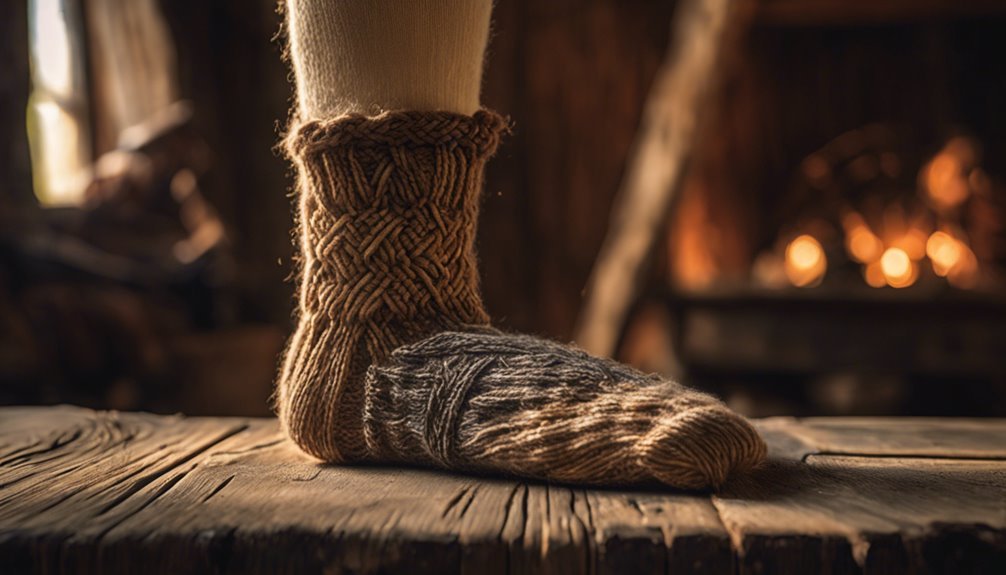
When considering Viking society, you can see that woolen socks played an important role both regarding practicality and craftsmanship. Evidence from archaeological finds, such as those in York and Jorvik, indicates that socks were crafted using intricate techniques like nalbinding, which guaranteed durability and warmth. These socks were not just functional but vital in daily life, protecting feet from the harsh Scandinavian climate and demonstrating the skill of the wearer's household.
Woolen Sock Materials
In Viking society, woolen socks were a staple, offering more than just comfort and warmth; they played a significant role in daily life and social status. Wool properties made these socks ideal for the harsh Scandinavian climate. Let's explore how:
- Insulation: Wool's natural fibers trapped heat, keeping feet warm even when wet.
- Durability: Wool's resilience guaranteed socks withstand rugged terrains.
- Breathability: The fiber's structure allowed moisture to escape, reducing foot odor.
- Versatile Designs: Different sock designs reflected status and individuality.
Wool's adaptability allowed for various sock designs, from simple to intricate patterns. The choice of design could indicate one's social standing or personal freedom. By understanding these materials, you appreciate the Vikings' clever use of resources to meet both practical and societal needs.
Sock Crafting Techniques
Although often overlooked, the artistry involved in Viking sock crafting was a meticulous process that combined both skill and cultural expression. You'd find that sock weaving wasn't just about keeping feet warm; it was an intricate craft reflecting historical patterns and societal values. The Vikings used techniques like nålebinding, a precursor to knitting, which allowed them to create complex designs. Each stitch and loop was a demonstration of their mastery and ingenuity.
Importance in Daily Life
Despite their seemingly mundane purpose, socks held significant importance in Viking daily life, serving both functional and symbolic roles. You might wonder how something so simple could be so crucial. Let's break it down:
- Protection from the Elements: The harsh Scandinavian climate demanded robust solutions. Socks, crafted from wool, provided essential warmth.
- Durability for Travel: Vikings were skilled navigators and traders. Durable socks guaranteed comfort during long voyages.
- Social Status Indicator: Quality and craftsmanship of socks often reflected one's social standing, symbolizing wealth and status.
- Daily Wear Essentials: Beyond practicality, socks were a staple in Viking attire, integrated into their everyday routines.
In essence, socks functionality transcended mere footwear; they were a cornerstone of Viking identity and survival.
Cultural Significance of Footwear Among Vikings
While often overlooked, the cultural significance of footwear among the Vikings offers a fascinating lens through which to understand their society. Footwear wasn't just a practical necessity but a reflection of one's cultural identity and social status. The materials and craftsmanship involved in Viking shoes provided insights into their societal structures. For instance, high-quality leather boots might indicate a person's elevated status within the community, while simpler shoes could suggest a more modest standing.
Evidence from archaeological sites shows that shoes varied in style and complexity, revealing a nuanced social hierarchy. Vikings used footwear as a subtle form of expression, much like you might use fashion today. This reveals a culture where freedom of expression was woven into the very fabric—literally—of their daily lives.
Comparisons With Other Ancient Cultures' Footwear
When you compare Viking footwear to that of other ancient cultures, you'll notice intriguing differences and similarities. Roman sandals, often paired with woolen socks, highlight a practical approach to footwear, while Egyptian innovations, such as the use of reeds and leather, showcase a blend of artistry and utility. These examples provide a framework to understand how different environments and resources influenced the evolution of footwear across civilizations.
Roman Sandals and Socks
Even though the Romans are often celebrated for their engineering and military prowess, their contributions to footwear, particularly the combination of sandals and socks, offer a fascinating lens through which to compare other ancient cultures' footwear innovations. Roman sandals paired with socks were not merely practical; they reflected distinct footwear preferences and ancient designs. Imagine the aesthetic and functional blend:
- Leather Roman sandals: crafted for durability and adaptability in diverse terrains.
- Sock styles: often woolen, providing warmth during colder climates.
- Footwear preferences: dictated by class and occupation, influencing design variations.
- Ancient designs: emphasized both practicality and social status.
Such combinations highlight the Romans' desire for comfort without compromising freedom of movement, a reflection of their ingenuity in everyday life.
Egyptian Footwear Innovations
Roman footwear preferences, with their practical yet innovative blend of sandals and socks, set a fascinating stage for comparing the footwear of ancient civilizations such as the Egyptians. Egyptian sandals were typically crafted from papyrus or leather, showcasing a minimalist design prioritizing breathability in the arid climate. Unlike the Romans, who sometimes used socks, Egyptians often opted for linen footwraps, which provided comfort and protection without compromising the freedom of movement. This choice reflects a culture deeply connected to its environmental needs and social hierarchies, where footwear indicated status. While Romans innovated with their leather sandals and woolen socks, Egyptian ingenuity lay in their ability to adapt materials to local conditions, offering a unique blend of functionality and cultural expression.
Adaptations for Harsh Climates
While the Vikings are often romanticized as fierce warriors, their ability to adapt to harsh climates was equally remarkable, demonstrating their practical ingenuity. You'd be amazed at how their footwear showcased climate resilience through clever design. Their shoes and boots were crafted to guarantee thermal insulation, essential for survival in freezing conditions. Imagine these details:
- Layers of Fur and Wool: Insulating the feet from biting cold.
- Thick Leather Soles: Protecting against icy surfaces and water.
- Flexible Construction: Allowing movement and comfort during long journeys.
- Durable Stitching: Assuring longevity and strength in footwear.
These adaptations highlight the Vikings' resourcefulness, marrying function with necessity. You can see how their practical solutions guaranteed freedom to explore and conquer, regardless of unforgiving weather.
Insights From Historical Texts on Viking Attire
The ingenuity displayed in Viking footwear is echoed in their broader attire, as chronicled in various historical texts. You'll find descriptions in sagas and chronicles that highlight their practicality and adaptability. Viking clothing was crafted to endure harsh climates, with wool, linen, and leather as predominant materials. The emphasis on layering provided versatility and warmth, essential for survival in Scandinavian winters.
Historical footwear, like the robust turnshoe, was designed for both protection and mobility. Sources like the Oseberg tapestry depict these shoes paired with woolen socks, suggesting a thoughtful approach to comfort. Such texts reveal a culture deeply attuned to its environment, where clothing was not just functional, but a reflection of the Vikings' resourcefulness and freedom-loving spirit.
The Modern Legacy of Viking Footwear
Many influences from Viking footwear have permeated modern shoe design, reflecting a blend of form and function that remains relevant today. Viking fashion emphasized practicality, yet it didn't sacrifice style, offering insights for today's innovative designs. Consider these elements:
- Durability: Viking shoes, crafted for harsh climates, inspire today's weather-resistant boots.
- Comfort: Soft, natural materials used by Vikings inform modern ergonomic shoe designs.
- Sock Symbolism: Viking socks, emphasizing warmth and protection, mirror current trends in cozy, functional sock-wear.
- Minimalism: The simple lines of Viking footwear resonate with today's minimalist aesthetic.
As you explore modern shoe options, observe how these ancient influences offer both freedom and protection, a reflection of the enduring legacy of Viking fashion and its practical, symbolic elements.
Frequently Asked Questions
Were Viking Socks Dyed in Specific Colors for Different Purposes?
Imagine discovering only 7% of Viking textiles were dyed. You'd wonder about the symbolism in their socks. They used natural dye techniques, possibly coloring socks for status or ceremony. Analyze these details to explore cultural freedom.
Did Vikings Use Any Specific Patterns or Designs on Their Socks?
You'd find that Vikings embraced intricate sock weaving, though specific historical patterns remain elusive. Evidence suggests they valued practicality over decorative designs, favoring functional warmth. Still, occasional patterns likely reflected personal or regional preferences, hinting at individuality.
How Did Viking Children's Socks Differ From Those of Adults?
When examining Viking children's socks, you'll notice differences in historical sock sizes compared to adults. Children's textile choices often leaned towards softer, more flexible materials, allowing for freedom of movement, while still embodying practical and resilient design principles.
Were Any Specific Animals Used for Viking Sock Materials?
Imagine discovering a Viking sock made from sheep's wool, illustrating how animal sources provided essential textile materials. By analyzing such artifacts, you can grasp the resourcefulness and adaptability of Viking societies in their quest for comfort and warmth.
Did Socks Play a Role in Viking Burial Rituals?
You're curious about Viking burial customs and sock symbolism. Evidence suggests socks weren't central in rituals, but they might've symbolized warmth and care, aligning with beliefs in providing essentials for the afterlife. It's a nuanced topic.

